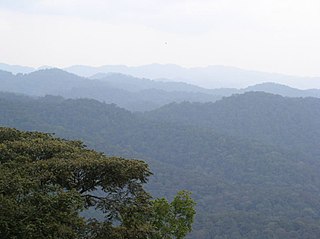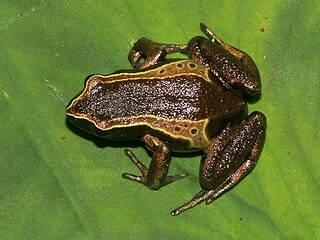
Cardioglossa is a genus of frogs in the family Arthroleptidae known as long-fingered frogs. They are native to western and central Africa, with the greatest species richness in Cameroon. They are found near streams in lowland and mountain forests, but also occur in other highland habitats near streams at up to 2,700 m (8,900 ft) in altitude. These are small frogs with a snout-to-vent length of 2 to 4 cm (0.8–1.6 in). Some of the more localized species are threatened.

The Albertine Rift montane forests is a tropical moist broadleaf forest ecoregion in east-central Africa. The ecoregion covers the mountains of the northern Albertine Rift, and is home to distinct Afromontane forests with high biodiversity.
Arthroleptis adolfifriederici is a species of frog in the family Arthroleptidae. It is found in the eastern Democratic Republic of the Congo, Rwanda, Burundi, and Uganda. Several common names have been coined for it, including Rugege Forest squeaker, Rugegewald squeaker, Adolf Friedrich's squeaker frog, and Adolf's squeaker.
Arthroleptis schubotzi, also known as the Burundi screeching frog, Schubotz's squeaker, and Kivu dwarf litter frog, is a species of frog in the family Arthroleptidae. It is found in the African Rift Valley in eastern Democratic Republic of the Congo (Kivu), southwestern Tanzania, Burundi, Rwanda, and western Uganda. There are taxonomic problems in delimiting this species.
Cardioglossa elegans is a species of frog in the family Arthroleptidae. It is found in southwestern Cameroon, Equatorial Guinea, and south to central Gabon. Common name elegant long-fingered frog has been coined for it.

Cardioglossa gracilis is a species of frog in the family Arthroleptidae. It is found in Cameroon, Central African Republic, Democratic Republic of the Congo, Equatorial Guinea, Gabon, Nigeria, and possibly Republic of the Congo. Its natural habitats are subtropical or tropical moist lowland forests, subtropical or tropical moist montane forests, and rivers. It is threatened by habitat loss.

Cardioglossa leucomystax is a species of frog in the family Arthroleptidae. It is found in large parts of Central Africa, extending into south-easternmost West Africa (Nigeria). The type locality is Cap Saint Jean in Equatorial Guinea. Populations from the Upper Guinean Forests of West Africa between Ghana and Sierra Leone previously allocated to this species were in 2008 described as a new species, Cardioglossa occidentalis. Common name silver long-fingered frog has been coined for Cardioglossa leucomystax.
Cardioglossa melanogaster is a species of frog in the family Arthroleptidae. It is found in the mountains of western Cameroon and eastern Nigeria. Common name Amiet's long-fingered frog has been coined for it.

Cardioglossa oreas is a species of frog in the family Arthroleptidae. It is endemic to Cameroon and known from the Western High Plateau between Mount Oku and the Bamboutos Mountains. Records from Mount Manengouba refer to Cardioglossa manengouba.
Cardioglossa pulchra is a species of frog in the family Arthroleptidae. It is found in the Cameroon Range in western Cameroon and in the Obudu Plateau in adjacent eastern Nigeria. Common name black long-fingered frog has been coined for it.
Cardioglossa schioetzi is a species of frogs in the family Arthroleptidae. It is found in the mountains of Cameroon and eastern Nigeria. Specifically, it has been recorded from the Oshie-Obudu Range, Gotel Mountains, Mount Oku, and Mount Mbam. It is a generally poorly known species.
Cardioglossa trifasciata is a species of frog in the family Arthroleptidae. It is endemic to western Cameroon and only known from the southern slopes of Mount Manengouba. Common name Nsoung long-fingered frog has been coined for it.
Cardioglossa venusta is a species of frog in the family Arthroleptidae. It is endemic to the mountains of western Cameroon. Specifically, it is known from Mount Manengouba, the Bamileke Highlands, Mount Nlonako, and the Rumpi Hills. Common name highland long-fingered frog has been coined for it.
Hyperolius discodactylus is a species of frogs in the family Hyperoliidae. It occurs in the montane areas of eastern Democratic Republic of the Congo and western Uganda, Rwanda, and Burundi. It is also known as the Albertine Rift reed frog, highland reed frog, or disc-fingered reed frog.
Leptopelis karissimbensis is a species of frog in the family Arthroleptidae. It is found in the highlands of western Rwanda and southwestern Uganda and in the adjacent eastern Democratic Republic of the Congo. It is very similar to Leptopelis kivuensis and has been confused with that species. Common names Karissimbi forest treefrog and Karissimbi tree frog have been coined for it.

Leptopelis kivuensis is a species of frog in the family Arthroleptidae. It is found in the highlands of western Burundi, Rwanda, and Uganda, and in the extreme eastern Democratic Republic of the Congo. It has been considered synonym of Leptopelis karissimbensis, and has been confused with that species. Common names Kisenyi forest treefrog and Kivu tree frog have been coined for it.
Leptopelis anebos, the young Itombwe forest treefrog, is a frog in the genus Leptopelis found in the Democratic Republic of the Congo and Congo. The young Itombwe forest treefrog was scientifically described in 2014 by Portillo & Greenbaum. It's morphologically similar to L. modestus and L. karissimbensis.

Cardioglossa annulata, the annulated long-fingered frog, is a species of frog from the genus Cardioglossa native to Congo in elevations of 634 to 744 m. It lives in forests and wetlands in a 610 km2 (240 sq mi) area. It was scientifically described in 2015.
Cardioglossa congolia, the Congolian long-fingered frog, is a species of frog native to the Democratic Republic of Congo and Congo that is a member of the Cardioglossa genus. It's found in elevations of 474 to 515 m. Cardioglossa congolia is part of a subclade with five other species of the Cardioglossa genus, according to analysis of the mitochondrial 16S rRNA gene.
Cardioglossa inornata is a species of frog from the Cardioglossa genus. It is native to the Republic of Congo and the Democratic Republic of Congo. The species was first described in 1952 by Laurent. It lives in forests and wetlands and has an elevation range of 1,900 to 2,000 m.






